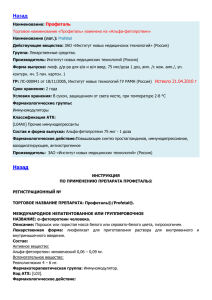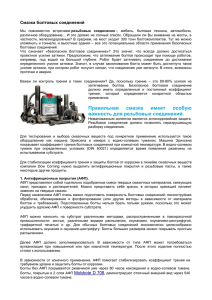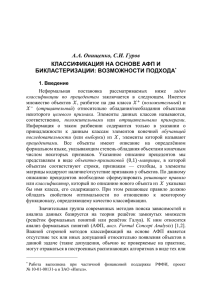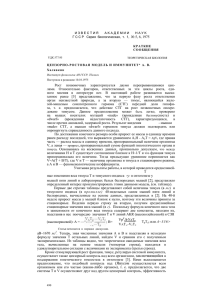Антифризные белки. Сообщение I. Классификация и механизм
реклама
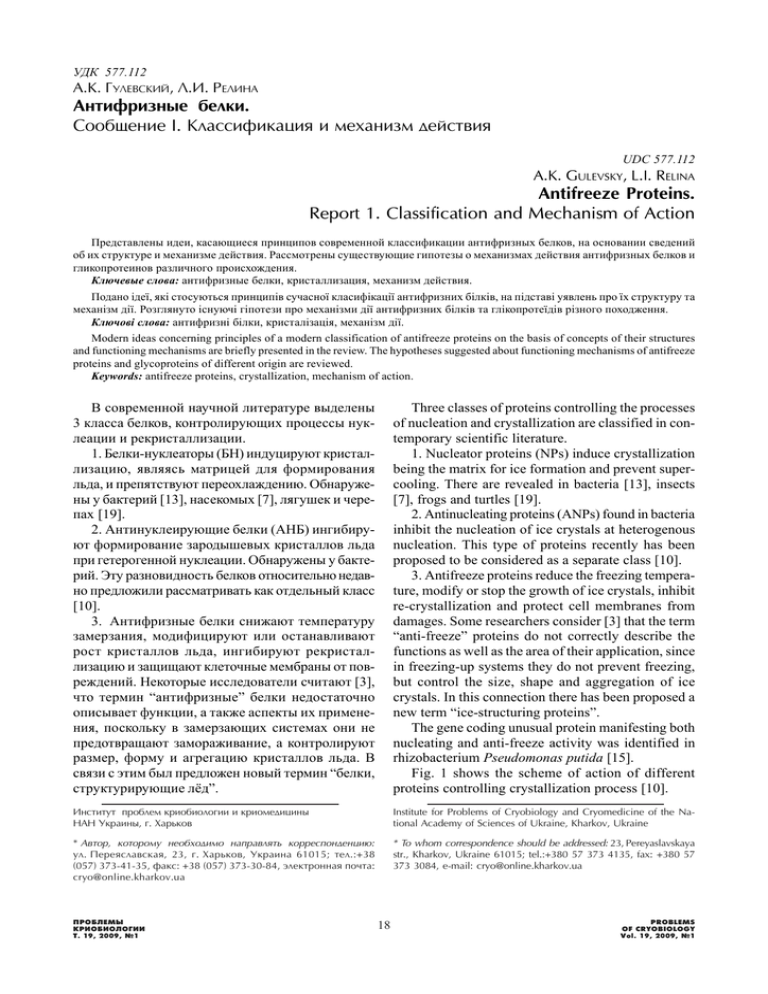
УДК 577.112 А.К. ГУЛЕВСКИЙ, Л.И. РЕЛИНА Антифризные белки. Сообщение I. Классификация и механизм действия UDC 577.112 A.K. GULEVSKY, L.I. RELINA Antifreeze Proteins. Report 1. Classification and Mechanism of Action Представлены идеи, касающиеся принципов современной классификации антифризных белков, на основании сведений об их структуре и механизме действия. Рассмотрены существующие гипотезы о механизмах действия антифризных белков и гликопротеинов различного происхождения. Ключевые слова: антифризные белки, кристаллизация, механизм действия. Подано ідеї, які стосуються принципів сучасної класифікації антифризних білків, на підставі уявлень про їх структуру та механізм дії. Розглянуто існуючі гіпотези про механізми дії антифризних білків та глікопротеїдів різного походження. Ключові слова: антифризні білки, кристалізація, механізм дії. Modern ideas concerning principles of a modern classification of antifreeze proteins on the basis of concepts of their structures and functioning mechanisms are briefly presented in the review. The hypotheses suggested about functioning mechanisms of antifreeze proteins and glycoproteins of different origin are reviewed. Keywords: antifreeze proteins, crystallization, mechanism of action. В современной научной литературе выделены 3 класса белков, контролирующих процессы нуклеации и рекристаллизации. 1. Белки-нуклеаторы (БН) индуцируют кристаллизацию, являясь матрицей для формирования льда, и препятствуют переохлаждению. Обнаружены у бактерий [13], насекомых [7], лягушек и черепах [19]. 2. Антинуклеирующие белки (АНБ) ингибируют формирование зародышевых кристаллов льда при гетерогенной нуклеации. Обнаружены у бактерий. Эту разновидность белков относительно недавно предложили рассматривать как отдельный класс [10]. 3. Антифризные белки снижают температуру замерзания, модифицируют или останавливают рост кристаллов льда, ингибируют рекристаллизацию и защищают клеточные мембраны от повреждений. Некоторые исследователи считают [3], что термин “антифризные” белки недостаточно описывает функции, а также аспекты их применения, поскольку в замерзающих системах они не предотвращают замораживание, а контролируют размер, форму и агрегацию кристаллов льда. В связи с этим был предложен новый термин “белки, структурирующие лёд”. Three classes of proteins controlling the processes of nucleation and crystallization are classified in contemporary scientific literature. 1. Nucleator proteins (NPs) induce crystallization being the matrix for ice formation and prevent supercooling. There are revealed in bacteria [13], insects [7], frogs and turtles [19]. 2. Antinucleating proteins (ANPs) found in bacteria inhibit the nucleation of ice crystals at heterogenous nucleation. This type of proteins recently has been proposed to be considered as a separate class [10]. 3. Antifreeze proteins reduce the freezing temperature, modify or stop the growth of ice crystals, inhibit re-crystallization and protect cell membranes from damages. Some researchers consider [3] that the term “anti-freeze” proteins do not correctly describe the functions as well as the area of their application, since in freezing-up systems they do not prevent freezing, but control the size, shape and aggregation of ice crystals. In this connection there has been proposed a new term “ice-structuring proteins”. The gene coding unusual protein manifesting both nucleating and anti-freeze activity was identified in rhizobacterium Pseudomonas putida [15]. Fig. 1 shows the scheme of action of different proteins controlling crystallization process [10]. Институт проблем криобиологии и криомедицины НАН Украины, г. Харьков Institute for Problems of Cryobiology and Cryomedicine of the National Academy of Sciences of Ukraine, Kharkov, Ukraine * Автор, которому необходимо направлять корреспонденцию: ул. Переяславская, 23, г. Харьков, Украина 61015; тел.:+38 (057) 373-41-35, факс: +38 (057) 373-30-84, электронная почта: [email protected] * To whom correspondence should be addressed: 23, Pereyaslavskaya str., Kharkov, Ukraine 61015; tel.:+380 57 373 4135, fax: +380 57 373 3084, e-mail: [email protected] ПРОБЛЕМЫ КРИОБИОЛОГИИ Т. 19, 2009, №1 18 PROBLEMS OF CRYOBIOLOGY Vol. 19, 2009, №1 There are some papers devoted to action mechanisms of antifreeze proteins (AFPs). Therefore we just briefly will specify the main ideas. According to cluster model of ice structure [1] a crystal in the norm grows along the axis a (Fig. 2), since this is energetically profitable. AFP I, for those initially the hypothesis about the mechanism of AFP action was formulated, preferably bind with prismatic surfaces parallel <211>[5] by means of dipole interactions and hydrogen bonds, since an ice lattice from this side is complementary to the structure of biological antifreezes in their active conformation (Fig. 2). This results in the ordering of water dipole molecules in the given plane (shaded area, Fig. 2). Towards the axis c the crystal growth is nor energetically profitable. Basal surface remains unordered and ice gets growing on it (towards the axis c) at temperature decrease and shift of thermodynamical balance. AFPs bind with again appeared facets. The alteration of these events results in the formation of ice crystals of bipiramidal shape. Due to discovery of new AFPs this conception is necessary to be reconsidered and added. According to current notions the known AFPs on the efficiency Рис. 1. Схема действия различных белков контроля кристаллизации. Fig. 1. Diagram of different proteins’ effect to control crystallization. Из ризобактерии Pseudomonas putida был идентифицирован ген, который кодирует необычный белок, проявляющий как нуклеирующую, так и антифризную активность [15]. На рис. 1 изображена схема действия различных белков, контролирующих процесс кристаллизации [10]. Существуют работы, посвященные механизмам действия антифризных протеинов (АФП). Поэтому мы лишь кратко раскроем основные идеи. Согласно кластерной модели структуры льда [1] кристалл в норме растет вдоль оси а (рис. 2), так как это энергетически выгодно. АФП I, для которых изначально была сформулирована гипотеза о механизме действия АФП, предпочтительно связываются с призматическими поверхностями, параллельными <211> [5] посредством дипольных взаимодействий и водородных связей, поскольку решетка льда с этой стороны комплементарна структуре биологических антифризов в их активной конформации (рис. 2). Это приводит к упорядочиванию молекул-диполей воды в данной плоскости (зашрихованная область, рис. 2). В направлении оси с рост кристалла энергетически невыгоден. Базальная поверхность остаётся неупорядоченной и лед продолжает нарастать на ней (в направлении оси с) при понижении температуры и сдвиге термодинамического равновесия. АФП связываются с вновь возникшими гранями. Чередование этих событий приводит к образованию кристаллов льда бипирамидальной формы. В связи с открытием новых АФП данную концепцию необходимо пересматривать и дополнять. ПРОБЛЕМЫ КРИОБИОЛОГИИ Т. 19, 2009, №1 Рис. 2. Схематическое изображение взаимодействия АФП I с кристаллом льда. Fig. 2. Scheme of AFPs I interaction with ice crystal. 19 PROBLEMS OF CRYOBIOLOGY Vol. 19, 2009, №1 Согласно современным представлениям, известные АФП по эффективности действия можно разделить на 3 группы. На рис. 3 приведена зависимость активности АФП от их концентрации в растворе [17]. Несмотря на установленные существенные различия в активности гиперактивных и умеренных АФП, пока отсутствуют данные о белках с промежуточной активностью. 1. “Очень слабые” АФП, основная функция которых – ингибирование рекристаллизации, вследствие их чрезвычайно слабой термогистерезисной активности. К представителям этой группы относится белок паслёна горько-сладкого Solanum dulcamara [9]. На С-конце он содержит 10 последовательных повторов, что является общей чертой большинства АФП. Анализ показал, что структура этих АФП содержит 2 консервативные области длиной по 56 и 57 аминокислотных остатков, которые организованы в 2 “цинковых пальца”. Другой представитель этой группы – белок из многолетнего плевела Lolium perenne [16], содержащий углеводную часть. При исследовании гликозилированных и негликозилированных форм выявлено, что с кристаллом связывается полипептидный остов. Вторичная структура этого АФП представляет собой β-складчатый слой. Несмотря на некоторую термогистерезисную активность, к данной группе белков также относят АФП с молекулярной массой 36 кДа моркови Daucus carota, выделенный из апопласта корней [18]. Этот белок также содержит углеводную часть на N-конце. 2. Умеренно активные АФП. К этой группе относится большинство известных АФП I–III типов и антифризные гликопротеиды (АФГП) рыб, бактерий и т.д. Подробная характеристика представителей этой многочисленной группы будет представлена в следующем сообщении, посвященном распространению антифризных белков в природе. В настоящей работе описаны основные отличия этой группы белков от белков с иными характеристиками активности. 3. Гиперактивные АФП, к которым относят АФП камбалы, некоторые АФП бактерий и насекомых. При охлаждении растворов, содержащих умеренно активные АФП, ниже точки равновесия начинается внезапный рост кристаллов льда вдоль оси с (см. рис. 2) [17]. Этот процесс в присутствии любого гиперактивного АФП остается контролируемым при более низких температурах, а затем начинается взрывообразный рост в направлении, перпендикулярном к оси с. При этом образуются кристаллы гексагональной формы с ярко выраженными плоскими базальными гранями. Поэтому авторы считают, что гиперактивные АФП блокируют рост кристаллов за пределами базальных поверхностей, а умеренно активные АФП оставПРОБЛЕМЫ КРИОБИОЛОГИИ Т. 19, 2009, №1 6 Термогистерезис, °С Thermal hysteresis, °С 5 4 3 2 1 0 1 2 3 4 5 6 7 8 Концентрация АФП, мМ AFPs’ concentration, mM Рис. 3. Термогистерезисная активность гиперактивных и умеренно активных АФП [17]: 1 – рекомбинантные АФП Archips fumiferana и Marinomonas primoryensis, натуральный АФП камбалы; 2 – рекомбинантный АФП Tenebrio molitor и натуральный АФП снежной блохи; 3 – умеренно активные натуральные, рекомбинантные и синтетические АФП рыб I–III типов и АФГП. Fig. 3. Thermal hysteresis activity of hyperactive and moderately active AFPs [17]: 1 – recombinant AFPs of Archips fumiferana and Marinomonas primoryensis, natural flounder AFPs; 2 – recombinant AFPs of Tenebrio molitor and natural AFPs of snow flea; 3 – moderately active natural, recombinant and synthetic fish AFPs of I–III types and AFGP. of action may be divided into 3 groups. Fig. 3 demonstrates the dependence of activity of AFPs on their concentration in the solution [17]. In spite of the established significant differences in the activity of hyperactive and moderate AFPs there have been no data about the proteins with intermediate activity yet. 1. “Very weak” AFPs, inhibiting the re-crystallization due to their very weak thermohysteresis activity. To the representatives of this group the protein of bitter nightshade Solanum dulcamara is referred [9]. At the C-terminal it contains 10 consequent repeats that is a common feature of the majority of AFPs. The analysis has shown that the structure of these AFPs possesses 2 conservative areas with the lengths of 56 and 57 amino acid residues, which are organized into 2 “zinc fingers”. Another representative of this group, the protein from long-standing darnel Lolium perenne [16] contains carbohydrate part. However during the study of glycosylated and non-glycosylated forms it has been found that polypeptide skeleton binds with the crystal. The secondary structure of this AFP represents β-sheet. In spite of some thermohysteresis activity to this group of proteins the AFP with molecular weight of 36 kDa of the carrot Daucus carota isolated from apoplast of roots [18] is also 20 PROBLEMS OF CRYOBIOLOGY Vol. 19, 2009, №1 referred. This protein also contains the carbohydrate part on the N-terminal. 2. Moderately active AFPs. The majority of the known AFPs of I–III types and antifreeze glycoproteids (AFGPs) of fish, bacteria etc. are referred to this group. Detailed characteristics of the representatives of this numerous group will be presented in the following report, devoted to the dissemination of antifreeze proteins in nature. The present research describes the main differences of this group of proteins from those with other activity parameters. 3. Hyperactive AFPs, comprising the AFPs of flounder, some AFPs of bacteria and insects. During cooling of the solutions containing moderately active AFPs below the balance point the abrupt growth of ice crystals along the axis c starts (see Fig. 2) [17]. This process in presence of any hyperactive AFP remains to be controlled at lower temperatures and then the burst-like growth in the direction perpendicular to the axis c begins. Herewith the crystals of hexagonal shape with vividly manifested flat basal facets are formed. Therefore the authors believe that hyperactive AFPs block the crystal growth beyond the limits of basal surfaces and moderately active AFPs remain vulnerable the tips of bipyramidal crystals with minimum basal surface whereon the growth of crystals at moderate supercooling begins. Hyperactive AFPs prevent ice crystal growth on basal surface. The crystals forming in their presence have flat hexagonal shape with vividly manifested basal surface. This supposition demands further checking, for instance with AFPs labelled with fluorescent probes due to which the binding site of AFP with crystal can be properly determined. It is known that crystal tips not always be the start loci of nucleation. At the absence of AFPs the normal growth of ice crystals is accomplished along the axis a (see Fig. 2), since kinetic barrier for adsorption of H2O molecules towards the axis c is higher. In this connection one may suppose that AFPs may alter the thermodynamics of water freezing, but up to now no logical concept, joining all the existing notions on the mechanisms of functioning AFPs have been proposed. An alanine-rich helical protein of 16.7 kDa isolated from flounder blood plasma [14] is referred to hyperactive AFPs as well as recombinant and natural AFPs of insects. Herewith after comparison of their activities the presence of alien sites has been established as not explaining their quite high activity. An unusually big (above 1 mDa) Ca2+-dependent AFP with a high activity was revealed in Antarctic bacteria M. primoryensis [8]. There was a notion that AFPs are irreversibly bound with ice surface within the limits of hysteresis interval. However this contradicts some facts: different types of AFPs differ by thermohysteresis activities at equimolar concentrations; ice surface is not overheated ляют уязвимыми кончики бипирамидальных кристаллов с минимальной базальной поверхностью, на которых начинается рост кристаллов при умеренном переохлаждении. Гиперактивные АФП предотвращают рост кристаллов льда на базальной поверхности. Кристаллы, образующиеся в их присутствии, имеют плоскую, гексагональную форму с ярко выраженной базальной поверхностью. Это предположение требует дальнейшей проверки, например с помощью АФП, меченных флуоресцентными зондами, по которым можно точно определить место связывания АФП с кристаллом. Известно, что кончики кристалла не всегда бывают стартовыми локусами нуклеации. При отсутствии АФП нормальный рост кристаллов льда осуществляется вдоль оси а (см. рис. 2), так как кинетический барьер для адсорбции молекул Н2О в направлении оси с больше. В связи с этим можно предположить, что АФП могут изменять термодинамику замерзания воды, однако до настоящего времени не предложено единой логичной концепции, объединяющей все существующие представления о механизмах функционирования АФП. К гиперактивным АФП относят богатый аланином α-спиральный белок массой 16,7 кДа, выделенный из плазмы крови камбалы [14], а также рекомбинантные и натуральные АФП насекомых. Причем после сравнения их активностей было установлено, что наличие чужеродных участков не объясняет их чрезвычайно высокую активность. Необычно крупный (более 1 МДа) Са 2+ -зависимый АФП с высокой активностью был выявлен у антарктической бактерии M. primoryensis [8]. Существовало мнение, что АФП необратимо связываются с поверхностью льда в пределах гистерезисного промежутка. Однако это противоречит ряду фактов: различные типы АФП отличаются термогистерезисной активностью при эквимолярных концентрациях; поверхность льда не перегревается в присутствии АФП; кроме того, сила связи с поверхностью льда недостаточна для необратимого связывания. Существует гипотеза [11], учитывающая обмен молекулами АФП между льдом и раствором в точке таяния. За обратимой ассоциацией АФП следует необратимая их ассоциация на вновь образованных поверхностях кристаллов льда при понижении температуры ниже точки таяния. Необходимая сила связи достигается при “вмерзании” АФП в поверхность кристалла при субзамораживающих температурах. Различная термогистерезисная активность разных видов АФП объясняется особенностями их растворимости во время фазы обратимой ассоциации: низкая растворимость в воде приводит к увеличению доли молекул АФП, связанных с поверхностью льда в точке таяния. При этом с понижеПРОБЛЕМЫ КРИОБИОЛОГИИ Т. 19, 2009, №1 21 PROBLEMS OF CRYOBIOLOGY Vol. 19, 2009, №1 in the presence of AFPs; in addition, the strength of the bond with ice surface is not essential for irreversible binding. There is a hypothesis [11] taking into account the exchange of AFPs molecules between ice and solution in the melting point. AFPs irreversible association follows reversible one on newly formed ice crystal surfaces at temperature lowering below the melting point. Necessary bond force is achieved at freezing-in of AFPs into the surface of crystal under subfreezing temperatures. Different thermohysteresis activity of different types of AFPs is explained by the peculiarities of their solubility during the phase of reversible association: low solubility in water leads to the rise in the share of AFPs bound with ice surface in the melting point. Herewith with temperature reduction the density of irreversibly adsorbed AFPs increases and as a consequence the thermohysteresis activity grows. AFPs are found in vertebrates and invertebrates, plants, bacteria and fungi [2]. Different AFPs are bound with various surfaces of ice crystals and probably therefore no common mechanism explaining specificity and affinity of AFPs’ binding with ice has been proposed. The study of four non-homological fish and insect AFPs by means of site-directed mutagenesis has shown that the binding sites in all the proteins are quite flat and significant part of protein molecule is involved into binding with ice. These sites are partially hydrophobic, moreover in a greater extent than it was supposed [4]. It has been established that hydrophobic part of the binding sites is orientated towards liquid phase. However the number of hydrophobic sites is bigger that those exposed into liquid phase. The key role in a tight binding is likely played by complementarity of the surface, which is first of all provided by van der Waals forces and secondly by hydrogen bonds. Today there are 3 hypotheses explaining the AFPs activity [12]: – the first hypothesis is based on X-ray structure analysis, computer modeling and other physical methods; the key role of complementarity of oxygen atoms in ice lattice and the arrangements in protein molecule, responsible for hydrogen bonds is supposed; – the second hypothesis is based on site-directed mutagenesis and computer modeling; according to this hypothesis hydrophobic part of amphiphilic helix of AFP I is located at the ice-water interface; – the third hypothesis is also grounded on site-directed mutagenesis and computer modeling. It is supposed that AFPs located on ice-water surface affect the structure of crystal plane, which is later bound with. The first and second hypotheses establish the fact of binding or accumulation of protein on certain crystal surfaces, and according to the third one the protein itself participates in development of binding site. нием температуры повышается плотность необратимо адсорбированных АФП и, как следствие, растет термогистерезисная активность. АФП найдены у позвоночных и беспозвоночных животных, растений, бактерий и грибов [2]. Различные АФП связываются с разными поверхностями кристаллов льда и, возможно, поэтому единого механизма, объясняющего специфичность и аффинность связывания АФП со льдом, предложено не было. Исследование 4-х негомологичных АФП рыб и насекомых путем сайт-направленного мутагенеза показало, что сайты связывания во всех белках относительно плоские и в связывание со льдом вовлекается существенная часть белковой молекулы [4]. Эти сайты частично гидрофобны, причем в большей степени, чем предполагалось. Установлено, что гидрофобная часть сайтов связывания обращена к жидкой фазе. Однако количество гидрофобных участков больше, чем экспонируемых в жидкую фазу. Ключевую роль в тесном связывании, по-видимому, играет комплементарность поверхности, которая обеспечивается, в первую очередь, Ван-дер-Ваальсовскими взаимодействиями, а во вторую – водородными связями. В настоящее время существуют 3 гипотезы, объясняющие активность АФП [12]: – первая гипотеза основана на рентгеноструктурном анализе, компьютерном моделировании и других физических методах; предполагается ключевая роль комплементарности атомов кислорода в решетке льда и группировок в молекуле белка, ответственных за водородные связи; – вторая гипотеза основана на сайт-направленном мутагенезе и компьютерном моделировании; согласно данной гипотезе, гидрофобная часть амфифильной спирали АФП 1 располагается на границе лёд-вода; – третья гипотеза также основана на сайт-направленном мутагенезе и компьютерном моделировании; предполагается, что АФП, расположенные на поверхности лёд-вода, сами влияют на структуру плоскости кристалла, с которой далее связываются. Первая и вторая гипотезы подчеркивают факт связывания или накопления белка на определённых поверхностях кристалла, а согласно третьей гипотезе, белок сам участвует в развитии места связывания. В настоящее время ни одна из этих гипотез не опровергнута. Отметим, что в [6] опубликовано сообщение о способности АФП III рыб адсорбироваться не только на поверхности кристаллов льда, но и на поверхности частичек, являющихся центрами гетерогенной нуклеации. Таким образом, имеющиеся сведения пока не позволяют сформулировать гипотезу о едином меПРОБЛЕМЫ КРИОБИОЛОГИИ Т. 19, 2009, №1 22 PROBLEMS OF CRYOBIOLOGY Vol. 19, 2009, №1 Nowadays no one of these hypotheses is denied. It should be noted that it has been reported [6] about the ability of fish AFPs III to be adsorbed not only in ice crystal surface, but also on the one of particles being the centers of heterogeneous nucleation. Thus the available data have not allowed yet to specify the hypothesis about uniform action mechanism of AFPs and AFGPs. There is logical admission that during evolution in antifreezes there were set different ways of their activity realization, since they in the representatives of distant systematic taxons do not reveal homology and vary on their tertiary structure [2]. Later we will try to present the classification of different AFPs depending on their variety in different systematic taxons. ханизме действия АФП и АФГП. Поскольку антифризы у представителей далеких друг от друга систематических таксонов не обнаруживают гомологии и различны по своей третичной структуре [2], логично допустить, что в процессе эволюции у них установились различные способы реализации их активности. В дальнейшем мы попытаемся привести классификацию различных АФП в зависимости от их распространения в различных систематических таксонах. Литература 1. Аванов А.Л. Биологические антифризы и механизм их активности // Молекулярная биология.– 1990.– Т. 24, №3.– С. 581–597. 2. Barrett J. Thermal hysteresis proteins // Int. J. Biochem. Cell Biol.– 2001.– Vol. 33, Issue 2.– P. 105–117. 3. Clarke C.J., Buckley S.L., Lindner N. Ice structuring proteins – a new name for antifreeze proteins // Cryo Letters.– 2002.– Vol. 23, N2.– P. 89–92. 4. Davies P.L., Baardsnes J., Kuiper M.J. et al. Structure and function of antifreeze proteins // Phil. Trans. R. Soc. Lond. B. Biol. Sci.– 2002.– Vol. 357, N1423.– P. 927–935. 5. Davies P.L., Hew C.L. Biochemistry of fish antifreeze proteins // FASEB J.– 1990.– Vol.4.– P. 2460–2468. 6. Du N., Liu Y.X., Hew C.L. Ice nucleation inhibition: Mechanism of antifreeze by antifreeze protein // J. Biol. Chem.– 2003.– Vol. 278, N38.– P. 36000–36004. 7. Duman J.G. Antifreeze and ice nucleator proteins in terrestrial arthropods // Annu. Rev. Physiol.– 2001.– Vol. 63.– P. 327– 357. 8. Gilbert J.A., Davies P.L., Laybourn-Parry J. A hyperactive, Ca2+-dependent antifreeze protein in an Antarctic bacterium // JFEMS Microbiol. Lett.– 2005.– Vol. 245, N1.– P. 67–72. 9. Huang T., Duman J.G. Cloning and characterization of a thermal hysteresis (antifreeze) protein with DNA-binding activity from winter bittersweet nightshade, Solanum dulcamara // Plant. Mol. Biol.– 2002.– Vol. 48, N4.– P. 339– 350. 10. Kawahara H.J. The structures and functions of ice crystalcontrolling proteins from bacteria // Biosci. Bioeng.– 2002.– Vol. 94, N6.– P. 492–496. 11. Kristiansen E., Zachariassen K.E. The mechanism by which fish antifreeze proteins cause thermal hysteresis // Cryobiology.– 2005.– Vol. 51, N3.– P. 262–280. 12. Madura J.D., Baran K., Wierzbicki A. Molecular recognition and binding of thermal hysteresis proteins to ice // J. Mol. Recognition.– 2000.– Vol. 13, Issue 2.– P. 101–113. 13. Margaritis A., Bassi A.S. Principles and biotechnological applications of bacterial ice nucleation // Crit. Rev. Biotechnol.– 1991.– Vol. 11, N3.– P. 277–295. 14. Marshall C.B., Chakrabartty A., Davies P.L. Hyperactive antifreeze protein from winter flounder is a very long rod-like dimer of alpha-helices // J. Biol. Chem.– 2005.– Vol. 280, N18.– P. 17920–17929. 15. Muryoi N., Sato M., Kaneko S. et al. Cloning and expression of afpA, a gene encoding an antifreeze protein from the arctic plant growth-promoting rhizobacterium Pseudomonas putida GR12-2 // J. Bacteriol.– 2004.– Vol. 186, N17.– P. 5661–5671. 16. Pudney P.D., Buckley S.L., Sidebottom C.M. et al. The physico-chemical characterization of a boiling stable antifreeze protein from a perennial grass (Lolium perenne) // Arch. Biochem. Biophys.– 2003.– Vol. 410, N2.– P. 238–245. 17. Scotter A.J., Marshall C.B., Graham L.A. et al. The basis for hyperactivity of antifreeze proteins // Cryobiology.– 2006.– Vol. 53, N2.– P. 229–239. ПРОБЛЕМЫ КРИОБИОЛОГИИ Т. 19, 2009, №1 References 1. Avanov A.L. Biological antifreezes and mechanisms of their activity// Molekulyarnaya Biologiya.– 1990.– Vol. 24, N3.– P. 581–597. 2. Barrett J. Thermal hysteresis proteins // Int. J. Biochem. Cell Biol.– 2001.– Vol. 33, Issue 2.– P. 105–117. 3. Clarke C.J., Buckley S.L., Lindner N. Ice structuring proteins – a new name for antifreeze proteins // Cryo Letters.– 2002.– Vol. 23, N2.– P. 89–92. 4. Davies P.L., Baardsnes J., Kuiper M.J. et al. Structure and function of antifreeze proteins // Phil. Trans. R. Soc. Lond. B. Biol. Sci.– 2002.– Vol. 357, N1423.– P. 927–935. 5. Davies P.L., Hew C.L. Biochemistry of fish antifreeze proteins // FASEB J.– 1990.– Vol.4.– P. 2460–2468. 6. Du N., Liu Y.X., Hew C.L. Ice nucleation inhibition: Mechanism of antifreeze by antifreeze protein // J. Biol. Chem.– 2003.– Vol. 278, N38.– P. 36000–36004. 7. Duman J.G. Antifreeze and ice nucleator proteins in terrestrial arthropods // Annu. Rev. Physiol.– 2001.– Vol. 63.– P. 327– 357. 8. Gilbert J.A., Davies P.L., Laybourn-Parry J. A hyperactive, Ca2+-dependent antifreeze protein in an Antarctic bacterium // JFEMS Microbiol. Lett.– 2005.– Vol. 245, N1.– P. 67–72. 9. Huang T., Duman J.G. Cloning and characterization of a thermal hysteresis (antifreeze) protein with DNA-binding activity from winter bittersweet nightshade, Solanum dulcamara // Plant. Mol. Biol.– 2002.– Vol. 48, N4.– P. 339– 350. 10. Kawahara H.J. The structures and functions of ice crystalcontrolling proteins from bacteria // Biosci. Bioeng.– 2002.– Vol. 94, N6.– P. 492–496. 11. Kristiansen E., Zachariassen K.E. The mechanism by which fish antifreeze proteins cause thermal hysteresis // Cryobiology.– 2005.– Vol. 51, N3.– P. 262–280. 12. Madura J.D., Baran K., Wierzbicki A. Molecular recognition and binding of thermal hysteresis proteins to ice // J. Mol. Recognition.– 2000.– Vol. 13, Issue 2.– P. 101–113. 13. Margaritis A., Bassi A.S. Principles and biotechnological applications of bacterial ice nucleation // Crit. Rev. Biotechnol.– 1991.– Vol. 11, N3.– P. 277–295. 14. Marshall C.B., Chakrabartty A., Davies P.L. Hyperactive antifreeze protein from winter flounder is a very long rod-like dimer of alpha-helices // J. Biol. Chem.– 2005.– Vol. 280, N18.– P. 17920–17929. 15. Muryoi N., Sato M., Kaneko S. et al. Cloning and expression of afpA, a gene encoding an antifreeze protein from the arctic plant growth-promoting rhizobacterium Pseudomonas putida GR12-2 // J. Bacteriol.– 2004.– Vol. 186, N17.– P. 5661–5671. 23 PROBLEMS OF CRYOBIOLOGY Vol. 19, 2009, №1 18. Smallwood M., Worrall D., Byass L. et al. Isolation and characterization of a novel antifreeze protein from carrot (Daucus carota) // Biochem. J.– 1999.– Vol. 340, Pt. 2.– P. 385–391. 19. Storey K.B. Living in the cold: freeze-induced gene responses in freeze-tolerant vertebrates // Clin. Exp. Pharmacol. Physiol.– 1999.– Vol. 26, N1.– P. 57–63. 16. Scotter A.J., Marshall C.B., Graham L.A. et al. The basis for hyperactivity of antifreeze proteins // Cryobiology.– 2006.– Vol. 53, N2.– P. 229–239. 17. Pudney P.D., Buckley S.L., Sidebottom C.M. et al. The physico-chemical characterization of a boiling stable antifreeze protein from a perennial grass (Lolium perenne) // Arch. Biochem. Biophys.– 2003.– Vol. 410, N2.– P. 238–245. 18. Smallwood M., Worrall D., Byass L. et al. Isolation and characterization of a novel antifreeze protein from carrot (Daucus carota) // Biochem. J.– 1999.– Vol. 340, Pt 2.– P. 385–391. 19. Storey K.B. Living in the cold: freeze-induced gene responses in freeze-tolerant vertebrates // Clin. Exp. Pharmacol. Physiol.– 1999.– Vol. 26, N1.– P. 57–63. Поступила 10.06.2008 Рецензент Т.П. Линник Accepted in 10.06.08 ПРОБЛЕМЫ КРИОБИОЛОГИИ Т. 19, 2009, №1 24 PROBLEMS OF CRYOBIOLOGY Vol. 19, 2009, №1
